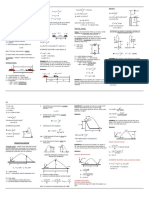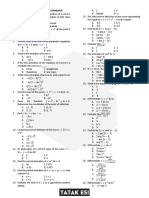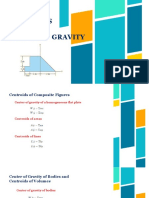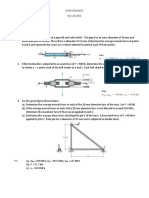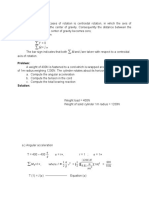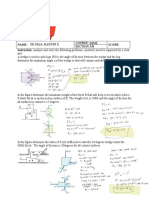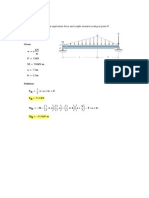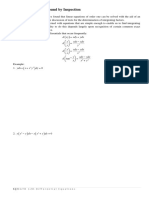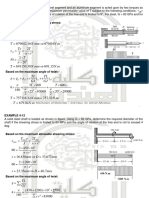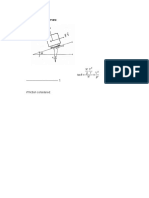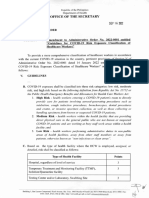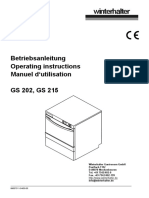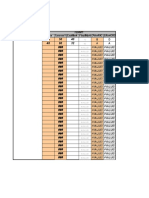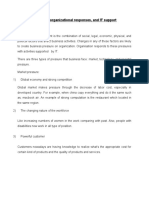A. Multiple Choice: Write the letter of the correct answer and 15.
15. Solve the general solution of the DE sin 𝑦 𝑑𝑦 + 𝑥 cos 𝑦 𝑑𝑥 =
𝑥2
show your solution in your paper.
𝑒 2 𝑑𝑥.
𝑥2 𝑥2
1. The first-order linear differential equation (linear in y) is an a. sin 𝑦 = 𝑒 − 2 (𝑐 − 𝑥) c. sin 𝑦 = 𝑒 2 (𝑐 + 𝑥)
equation of the form 𝑥2 𝑥2
a. 𝑦 ′ + 𝑃(𝑥)𝑦 = 𝑄(𝑥)𝑥 𝑛 c. 𝑥 ′ + 𝑅(𝑦)𝑥 = 𝑆(𝑦) b. cos 𝑦 = 𝑒 2 (𝑐 − 𝑥) d. cos 𝑦 = 𝑒 − 2 (𝑐 + 𝑥)
b. 𝑥 ′ + 𝑅(𝑦)𝑥 = 𝑆(𝑦)𝑥 𝑛 d. 𝑦 ′ + 𝑃(𝑥)𝑦 = 𝑄(𝑥)
16. What is the integrating factor for the non-exact DE
2. Is 𝑦 ′ = 𝑥 2 − 2𝑥𝑦, first order linear DE (FOLDE)? (2𝑥 2 𝑦 + 2𝑥𝑦 − 2𝑦 2 )𝑑𝑥 + (𝑥 2 − 2𝑦)𝑑𝑦 = 0?
a. No, because 𝑦 has the degree two a. 𝑥 2 c. 𝑒 2𝑥
𝑥
b. Yes because highest degree is two b. 𝑒 d. 𝑥 −2
c. Yes, since the degree of y and its derivative are all one
d. None of these 17. Find the general solution of the non-exact DE
(2𝑥 2 𝑦 + 2𝑥𝑦 − 2𝑦 2 )𝑑𝑥 + (𝑥 2 − 2𝑦)𝑑𝑦 = 0.
3. What is the standard form of 𝑦𝑑𝑥 = (2𝑥 − 𝑦 2 )𝑑𝑦, linear in a. 𝑥 2 + 4𝑥𝑦 − 2𝑥 + 4𝑦 2 − 6𝑦 = 𝑐
𝑥? b. 3𝑥 2 − 2𝑦 2 + 2𝑥𝑦 − 1 = 𝑐𝑥
a.
𝑑𝑦 2
− 𝑥 = −𝑦 c.
𝑑𝑥
− 2𝑥𝑦 = −𝑥 c. 𝑦(𝑥 2 − 𝑦) = 𝐶𝑒 −2𝑥
𝑑𝑥 𝑦 𝑑𝑦 d. 𝑦² + (2𝑥 – 3𝑦)𝑒 𝑥 = 𝑐
𝑑𝑥 2 𝑑𝑦 2
b. − 𝑥 = −𝑦 d. − 𝑦 = −𝑥
𝑑𝑦 𝑦 𝑑𝑥 𝑥
18. Find the P and Q functions of first order linear differential
4. How will you know if a differential equation is exact? equation 𝑥 2 𝑑𝑦 + 𝑦(2𝑥 − 3𝑦 2 )𝑑𝑥 = 0.
2 3 2
a.
∂M
=
𝜕𝑁
c.
∂M
≠
𝜕𝑁 a. ,− 2 c. , −3𝑦 2
𝑥 𝑥 𝑦
∂x 𝜕𝑦 ∂y 𝜕𝑥 2 2 3
b.
∂M
≠
𝜕𝑁
d.
∂M
=
𝜕𝑁 b. , 3𝑦 2 d. ,
𝑦 𝑥 𝑥2
∂x 𝜕𝑦 ∂y 𝜕𝑥
19. The integrating factor of the DE 𝑥 2 𝑑𝑦 + 𝑦(2𝑥 − 3𝑦 2 )𝑑𝑥 = 0
5. The differential equation 2𝑥𝑦𝑑𝑥 + (3𝑥 2 + 𝑦 2 )𝑑𝑦 = 0 is a/an
is
a. Linear DE c. Bernoulli DE
b. Exact DE d. None of the above a. 𝑥 −4 c. 𝑒 −𝑥
b. 𝑒 𝑥 d. 𝑥 −2
6. If the equation did not pass the test for exactness, the DE
is considered as 20. The particular solution of the DE 𝑥 2 𝑑𝑦 − 𝑦(2𝑥 + 3𝑦 2 )𝑑𝑥 = 0
a. Exact DE b. Linear DE when 𝑥 = 1 and 𝑦 = 1is
c. Non-Exact DE d. Homogeneous DE a. 𝑥 3 (𝑥 + 2𝑦 2 ) = 3𝑦 2 c. 𝑥 2 + 3𝑥𝑦 = 4𝑦
b. 𝑥 2 − 3𝑥𝑦 = −2𝑦 d. 2𝑥 + 4𝑦 2 − 6𝑦 = 4
7. The role of the integrating factor is to
a. make a given non-exact DE to an exact DE by 21. What is the integrating factor for the linear DE
multiplying it to the non-exact DE 𝑦 ′ = sec 𝑥 − 𝑦 sec 𝑥?
b. make a given non-exact DE to a linear DE by a. sec 𝑥 c. cos 𝑥
multiplying it to the non-exact DE b. csc 𝑥 − cot 𝑥 d. sec 𝑥 + tan 𝑥
c. multiply the non-exact DE and make it homogeneous
DE 22. The general solution for the linear DE 𝑦 ′ = sec 𝑥 − 𝑦 sec 𝑥 is
d. all of these a. 𝑦 sec 𝑥 = 𝑥 − cos 𝑥 + 𝑐
b. 𝑦(sec 𝑥 + tan 𝑥) = tan 𝑥 + sec 𝑥 + 𝑐
8. The standard form of Bernoulli’s differential equation c. 𝑦 cos 𝑥 = 𝑥 + sin 𝑥 + 𝑐
a. 𝑦 ′ + 𝑃(𝑥)𝑦 = 𝑄(𝑥)𝑦 𝑛 c.𝑀(𝑥, 𝑦)𝑑𝑥 + 𝑁(𝑥, 𝑦)𝑑𝑦 = 0 d. 𝑦(csc 𝑥 − cot 𝑥) = 𝑥 − sec 𝑥 + 𝑐
∂M 𝜕𝑁
b. ≠ d. 𝑦 ′ + 𝑃(𝑥)𝑦 = 𝑄(𝑥)
∂y 𝜕𝑥 23. Find the integrating factor of the DE (𝑥 + 𝑦)𝑑𝑥 + 2𝑥𝑑𝑦 = 0.
1
9. What is the integrating factor for the non-exact DE a. 𝑥 −2 c. 𝑥1/2
(3𝑥 2 + 2𝑦 2 + 1)𝑑𝑥 − 2𝑥(2𝑦 − 𝑥)𝑑𝑦 = 0? b. 𝑒 𝑥 d. 𝑥 −2
a. 𝑦 −1 c. 𝑒 2𝑥
b. 𝑒 𝑥
d. 𝑥 −2 24. Find the reduced functions of P and Q of the differential
equation (6𝑦 2 − 𝑥𝑦 − 𝑦)𝑑𝑥 + 𝑥𝑑𝑦 = 0.
1 6 1 6
10. Find the general solution of the non-exact DE a. 𝑃 = (1 + ), 𝑄 = ( ) c. 𝑃 = (1 − ), 𝑄 = ( )
𝑥 𝑥 𝑥 𝑥
(3𝑥 2 + 2𝑦 2 + 1)𝑑𝑥 − 2𝑥(2𝑦 − 𝑥)𝑑𝑦 = 0. 1 6 1 6
b. 𝑃 = (1 + ), 𝑄 = (− ) d. 𝑃 = (−1 − 𝑥), 𝑄 = (− 𝑥)
a. 𝑥 2 + 4𝑥𝑦 − 2𝑥 + 4𝑦 2 − 6𝑦 = 𝑐 𝑥 𝑥
b. 3𝑥 2 − 2𝑦 2 + 2𝑥𝑦 − 1 = 𝑐𝑥
c. 𝑥 2 + 4𝑥𝑦 + 4𝑥 + 10 ln 𝑦 = 𝑐 25. Solve the general solution of the DE
(6𝑦 2 − 𝑥𝑦 − 𝑦)𝑑𝑥 + 𝑥𝑑𝑦 = 0
d. 𝑦² + (2𝑥 – 3𝑦)𝑒 𝑥 = 𝑐
a. 𝑥𝑒 𝑥 = 𝑦(6𝑒 𝑥 + 𝐶) c. 𝑒 𝑥 = 𝑥𝑦(𝑒 𝑥 + 𝐶)
2𝑥 𝑥
11. The integrating factor of the DE 𝑥 2 𝑑𝑦 − 𝑦(2𝑥 + 3𝑦)𝑑𝑥 = 0 c. 𝑥𝑒 = 𝑦(𝑒 + 𝐶) d. 𝑒 2𝑥 = 𝑥𝑦(𝑒 𝑥 + 𝐶)
is
a. 𝑥 2 c. 𝑥 −1
b. 𝑒 𝑥 d. 𝑥 −2
12. The particular solution of the DE 𝑥 2 𝑑𝑦 − 𝑦(2𝑥 + 3𝑦)𝑑𝑥 = 0
when 𝑥 = 1 and 𝑦 = 1is
a. 𝑦(𝑥 2 − 𝑦) = −4𝑒 −2𝑥 c. 𝑥 2 + 3𝑥𝑦 = 4𝑦
2
b. 𝑥 − 3𝑥𝑦 = −2𝑦 d. 2𝑥 + 4𝑦 2 − 6𝑦 = 4
13. What is the integrating factor for the linear DE
3
𝑥 ′ + 𝑥 = 5𝑦?
𝑦
a. 𝑦3 c. 𝑒 −𝑥
b. 𝑒𝑥 d. 𝑥 −2
3
14. The general solution for the linear DE 𝑥 ′ + 𝑥 = 5𝑦 is
𝑦
a. 𝑥 −2 𝑦 = 5𝑥 + 𝑐
b. 𝑥𝑦 3 = 𝑦 5 + 𝑐
c. 3𝑥 2 − 2𝑦 2 + 2𝑥𝑦 − 1 = 𝑐𝑥
d. 𝑥 2 + 4𝑥𝑦 − 2𝑥 + 4𝑦 2 − 6𝑦 = 𝑐





